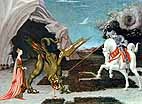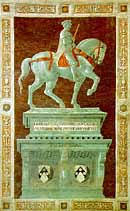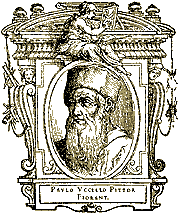Painter
Pratovecchio, Firenze 1397-1475
The son of Dono di Paolo, surgeon and barber, and Antonia di Giovanni del Beccuto, was not only a wonderful painter, rightly acclaimed over the centuries, but also an extremely original and rather "different" artist in the Florence that was awakening to the Renaissance: it is not at all surprising that his work, the result of the empiric and alternating directions of his continuous experimentation, contains many singular simularities that have been compared with the Cubist and Surrealist schools of this century.

St.George and the dragon
In 1407, when he was only 10 years old, Paolo was already working alongside
the young Donatello as an apprentice in Ghiberti's workshop on the finishing
touches of the first of the Baptistery doors.
He was almost immediately nicknamed "Uccello" (Bird) or "degli
Uccelli" (of the Birds) and this was probably because he especially
loved painting ornamental friezes with birds and other animals. There
is also a strong probability that he was also one of Gherardo Starnina's
students (a Florentine, who worked in Spain between the 14th and 15th
centuries and is believed to have been one of the "importers" of
the international Gothic style to Florence), as well as being the real
author of the fascinating Thebaid in the Uffizi.
Whether this is true or not, his formation did take place during the first two
decades of the fifteenth century when the Gothic style and figurative culture
were being subjected to continuous experimentation in the attempt to find a form
of perspective unity. Unfortunately Paolo Uccello, who became a member of the
Company of Painters of St. Luke in 1424, had already left Florence by 1425, because
he had been invited to Venice to carry out some mosaics (today lost) in St. Mark's.
The only example that remains of this early creative period is his Annunciation
(1425), containing some very complicated perspective, in the Carnesecchi Chapel
in Santa Maria Maggiore. He did not return for five years and was completely
uninformed about what had, in the meantime, been Masaccio's
revolution in the Carmine, while also knowing very little indeed about Brunelleschi's
(highly secret) project for the Cupola of Santa Maria
del Fiore, whose construction began in 1423.

Equestrian
monument
of John Hawkwood
Therefore, when he came home in 1431, he was artistically rather behind
the times as regards the marvellous new painting in Florence. He worked
in Santa Maria Novella (the Stories of
the Virgin in the Green Cloister, 1431
ca.) and in the Duomo, where, in 1436,
in only three months, he carried out the fresco of the equestrian monument
to the condottiere Sir John Hawkwood (or Giovanni
Acuto as he was known in Italy), which brought him great fame: the horse's
pose is similar to those in St. Mark's but the artist was more interested
in the geometrical forms than a natural effect and, as a result, the
entire fresco comes very close to the abstract painting of today. He
also carried out the decorations on the great clock (1443) in Santa
Maria del Fiore, placing four powerful heads of prophets at the corners,
as well as preparing the cartoons of the Resurrection and the Nativity
(1443-45) for two of the round stained-glass windows in the Cupola (the
so-called "eyes"). In this period he also painted the frescoes
in the Cathedral of Prato, in San Miniato
al Monte (the Stories of Sainted Monks), as well as a privately commissioned
series of small panels in what was still a Gothic and mythical style,
like those of St. George and the Dragon in Paris and London (1456 ca.).
In 1445 he was invited by Donatello to Padua where he painted some Giants (now
lost), which probably later influenced the young Mantegna, in the house of the
Vitaliani family. By 1447 he was back in Florence again and had started work
on the Stories of Noah in the Green Cloister in Santa
Maria Novella: the lunette of the Flood (1446-48) in particular is a quite
extraordinary piece of painting, for here the great artist seems to have wanted
to try and use as many perspective projections as he could; the picture is constructed
with a double vanishing point (only one is used in geometric perspective) and,
as a result, many lines appear confused because they do not centre on the same
point; the optic effects are increased and at times deform the figures, or otherwise
create some really daring effects of foreshortening.

The battle of S.Romano
This fresco is a real masterpiece that breaks away from all the established
rules.
The most important moment in Paolo Uccello's artistic career took place shortly
afterwards, between 1456 and 1460, when he carried out the three paintings that
celebrate the Battle of San Romano of 1432, where the Florentines, led by Niccolò da
Tolentino, attacked and defeated the Sienese allies of the Visconti family from
Milan. These three panels were carried out for a room in Palazzo Medici in Via
Larga (only one of them is in the Uffizi today, the other two are respectively
at the Louvre and the National Gallery in London) and summerize all the power
and fascination of this genius of painting. Let us examine the panel in the Uffizi:
an extremely crowded composition is placed in front of what is still a mediaeval
type of background landscape, showing Bernardino della Ciarda being unhorsed
and with warriors, armed with lances and crossbows, and horses painted in a variety
of positions in the foreground. However the conflicting throngs of combatents
are held together by the perspective, with the knights in armour almost looking
like robots, the spears forming palisades and the crests on the helmets almost
like bushes, while the atmosphere is rarified, with the brilliant colours creating
an inlaid polychrome result: taken as a whole, the effect is that of an unreal
game and, as such, will fascinate the Surrealists in this century.
Following this, the artist only carried out a few more predellas (the Miracle
of the Host, 1469, Urbino), some small panels of profane subjects and a series
of portraits, some in the style of Masaccio and others closer to the courtly
elegance of Pisanello, but his good fortune was by now on the wane. After a period
spent at the court of the Duke of Montefeltro at Urbino, he returned to Florence
in 1469 where, "more poor than famous" and weighed down by suffering
and economic worries, he was to die six years later.

